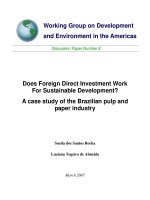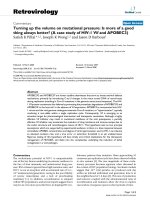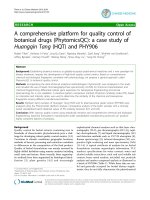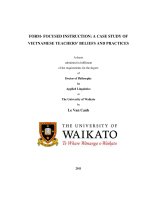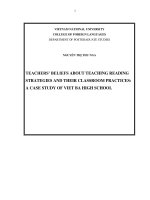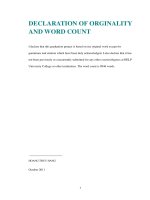Form- focused instruction- a case study of Vietnamese teachers’ beliefs and practices
Bạn đang xem bản rút gọn của tài liệu. Xem và tải ngay bản đầy đủ của tài liệu tại đây (2.9 MB, 367 trang )
FORM- FOCUSED INSTRUCTION: A CASE STUDY OF
VIETNAMESE TEACHERS’ BELIEFS AND PRACTICES
A thesis
submitted in fulfilment
of the requirements for the degree
of
Doctor of Philosophy
in
Applied Linguistics
at
The University of Waikato
by
Le Van Canh
2011
ii
Statement of Intellectual Ownership
This thesis contains no material which has been accepted for the award of any other
degree or diploma in any university.
To the best of my knowledge and belief this thesis contains no material previously
published by any other persons except where due acknowledgement has been made.
Signature:
Date: 31 March, 2011
iii
ABSTRACT
Despite the reported powerful influence of teachers‟ beliefs on their pedagogical
practices in the classroom, very few in-depth case studies of foreign language
teachers‟ beliefs and the correspondence between their beliefs and instructional
strategies have been internationally published – Woods (1996) being an important
exception. Moreover, not a single in-depth study has ever been conducted in the
context of Vietnamese state secondary schools, where teachers are non-native
speakers, resources are minimal, and access to published scholarship and research is
very limited.
The present qualitative case study seeks to occupy this research space because
contextual factors such as limited access to expert knowledge, teachers‟ isolation, a
prescribed curriculum, time constraints, and high-stake examinations need to be part
of any analysis of teachers‟ beliefs and the correlation between beliefs and practices.
It has explored the beliefs about form-focused instruction held by a group of eight
teachers with teaching experience ranging from 24 to 2 years and the relationship
between their beliefs and practices as well as factors shaping their beliefs. Eighteen
interviews (ranging from 30 to 60 minutes long) and observations of 24 naturally
occurring form-focused lessons in 12 groups of 10th, 11th, and 12th graders, i.e., all
grades of the upper secondary school level, and 18 hours of stimulated recall
interviews were conducted to collect the data. The audio- and video-recorded data
were fully transcribed and translated from Vietnamese into English, and were
subjected to a process of interpretative analysis through a constant comparison and
contrast of the various data.
As it is revealed in the study that teachers showed a strong inclination to adopt a
deductive approach to grammar with pupils memorising of grammatical rules and
terminology, and doing the controlled grammar exercises in the textbook as the best
way of learning grammar. Neither their beliefs nor practices were related to either
current theories of language learning within the mainstream Second Language
iv
Acquisition (SLA) research or to the methodology promoted in the prescribed
curriculum.
Findings of the study also indicate that while teachers‟ beliefs were affected by
multiple contextual factors, experiences which were accumulated through the process
of socialisation in their professional community played the most influential role.
Such beliefs constituted their personal theories for practice, which shaped what they
did in the classroom and how they did it. Thus, these teachers shared a „collectively
normative pedagogy‟, which was underpinned by their common beliefs and justified
by their common pattern of beliefs and practices.
Although this is a case study and as such it is not valid to make generalisations, it has
some significant contributions to add to an understanding of teachers‟ beliefs in terms
of research methodology and theoretical understanding with reference to teacher
cognition and teacher professional development in the specific educational context
where the teaching of English is undertaken by non-native-English-speaking teachers.
These are discussed in the concluding chapter, Chapter VII.
v
ACKNOWLEDEMENTS
The completion of this study is credited to many people‟s contributions and support. I
would like to take this opportunity to thank them all most sincerely.
My heartfelt appreciation goes to my supervisors, Dr. Roger Barnard and Dr. James
McLellan, for their continuous support and guidance throughout these years of
academic work. They are really caring and inspiring supervisors. They guided me
with their scholarship, academic rigour, and passion for learning; and they always
generously shared their wisdom, expertise, time and inspiration whenever I got stuck
in my research. The countless enlightening discussions I had with them deepened my
insights in this research. I felt that I was so fortunate to have had them as my
supervisors. Their social constructivist approaches, their sincerity and integrity as
scholars have taught me valuable, life-time lessons both in education and in life. I
cannot forget the first day when I happened to meet Dr. Roger Barnard at a
professional international conference and he encouraged me to enroll for my doctoral
study. Without such encouragement, I would have never taken this untrodden road of
doctoral learning at the age of 50. To me, Dr. Roger Barnard is not only my academic
supervisor, but also a big brother of mine. Both the personal and professional
conversations I had with him during my study were really useful learning experiences
to me. He challenged me to think and write with academic rigour. Without his
unfailing support, unflagging patience and unswerving inspiration, my PhD studies
and research would not be as fruitful and rewarding as they have been.
I am indebted to the eight teachers who participated in this study for their sharing,
enthusiastic participation and cooperation without which this dissertation would not
come into being. For ethical reasons, I cannot mention their names here, yet I am
keen to express my gratitude to them for their interest in my study and their
acceptance of my classroom observations and their sharing of time with me in those
lengthy in-depth interviews and stimulated recall sessions. I understand how busy
vi
teachers in my country are with all sorts of duties and responsibilities, and really
appreciate what they had done for my study.
I owe thanks to many people who cared for me, helped me and encouraged me in the
past few years. My special thanks go to Mrs.Yukari Barnard for her hospitality,
thoughtfulness, provision and the wonderful care she took of me. She is really my
caring big sister. I am specially thankful to Vuong Thi Bich Hanh and Le Tien Dung
for their assistance, logistic support and transport arrangements for my field trips. I
give my sincere thanks to Dr. Simon Borg for his useful suggestions for the data
analysis. My thanks go Dr. William Littlewood and Professor Alan Maley for helping
me with required references. I also thank all the professors of the Faculty of Arts and
Social Sciences (University of Waikato) for their friendliness and helpful assistance
throughout the challenging times of my doctoral studies.
I give my sincere thanks to all my students, colleagues and friends who patiently
listened to my frustrations, and provided me with encouragement, understanding and
collegiality.
Finally, my wholehearted appreciation goes to my beloved wife, Mrs. Ngo Thi Minh
Hang, and two children, Le Thi Thanh Thuy and Le Minh Nguyen, for their
emotional and material sacrifices as well as their understanding and unconditional
support. They were my anchors and their love was my sunshine in the past few years
and will always be.
vii
TABLE OF CONTENT
TITLE PAGE……………………………………………………………………… i
STATEMENT OF INTELLECTUAL OWNERSHIP ……………………………….ii
ABSTRACT iii
ACKNOWLEDEMENTS v
TABLE OF CONTENT viii
TRANSCRIPT CONVENTIONS xii
LIST OF ABBREVIATIONS xii
LIST OF TABLES xiii
CHAPTER I: INTRODUCTION 1
CHAPTER II: THE CONTEXT OF THE STUDY 9
2.1. Vietnam: Country, People, and Culture 9
2.2. Education in Vietnam 12
2.3. English Language Education in Vietnam 19
2.4. Teacher Education and Teacher Development in Vietnam 25
2.5. Summary 30
CHAPTER III: LITERATURE REVIEW 32
3. 1. Grammar and Form-Focused Instruction 32
3. 1. 1. Role of Grammar in Second Language Acquisition 32
3. 1. 2. Form-Focused Instruction in the Classroom 37
3. 1. 3. When Form-Focused Instruction Should Begin 43
3. 1. 4. Corrective Feedback 44
3. 1. 5. Use of First Language in Form-Focused Instruction 47
3. 2. Teachers‟ Beliefs 50
3. 2. 1. Defining Teachers‟ Beliefs 50
3. 2. 2. Factors that Shape Teachers‟ Beliefs 51
3. 2. 3. Teachers‟ Beliefs and Teachers‟ Knowledge 54
3. 3. Studies on Second Language Teachers‟ Beliefs and Practices 58
3. 3. 1. Pre-service and In-service Teachers‟ Beliefs about Language Learning
and Teaching 58
3. 3. 2. Relationship Between Teachers‟ Beliefs and Teachers‟ Instructional
Practices 61
viii
3. 3. 3. Factors that Influence the Transfer of Beliefs into Classroom Practices 67
3. 4. Studies on Teachers‟ Beliefs about Form-Focused Instruction 71
3. 4. 1. Studies on Teachers‟ Beliefs about Form-Focused Instruction Outside
Asia 71
3. 4. 2. Studies on Teachers‟ Beliefs about Form-Focused Instruction within
Asia 78
3. 5. Summary 84
CHAPTER IV: RESEARCH METHODOLOGY 86
4. 1. Research Design 86
4. 2. Rationale 92
4.3. Preliminary Study 94
4. 4. Present Study 96
4. 5. Selecting the Case 97
4. 6. Setting for the Case Study 99
4. 7. Semi-structured Interviews 105
4. 8. Classroom Observations 107
4. 9. Stimulated Recalls 109
4. 10. Role of the Researcher 111
4. 11. Data Analysis 114
4. 12. Validity and Reliability 118
4. 13. Credibility 120
4. 14. Transferability 122
4. 15. Dependability 123
4. 16. Confirmability 123
4. 17. Summary 124
CHAPTER V: FINDINGS: TEACHERS‟ BELIEFS AND PRACTICES
REGARDING FORM-FOCUSED INSTRUCTION 125
5. 1. Summary of the English Syllabus for the Upper Secondary School 127
5. 2. Beliefs about Grammar Learning 129
5. 2. 1. Importance of Grammar 129
ix
5. 2. 2. Grammar and Communication: The Role of Explicit Grammar
Knowledge 133
5. 2. 3. Approaches to Grammar 140
5. 3. Operationalization of Beliefs in the Classroom 144
5. 3. 1. Presentation through Sentence-level Examples 145
5. 3. 2. Focus on Explicit Teaching of Grammatical Rules and Terminology . 156
5. 3. 3. Proceduralising Explicit Knowledge through Practice 165
5. 3. 4. Corrective Feedback 174
5. 3. 5. Use of First Language 179
5. 4. Factors that Shape Teachers‟ Beliefs 187
5. 4. 1. Professional Training 187
5. 4. 2. Experiential Knowledge 188
5. 4. 3. Experience as Language Learners 190
5. 4. 4. Institutional Factors 191
5. 4. 5. Teaching Materials 192
5. 4. 6. Socialisation within Professional Community 193
5. 5. Summary 195
CHAPTER VI: DISCUSSION OF THE FINDINGS 202
6. 1. Teachers‟ Beliefs about Form-Focused Instruction 203
6. 2. Teachers‟ Beliefs as Reflected in the Practice of Grammar Teaching. 208
6. 2. 1. Grammar Presentation 208
6. 2. 2. Grammar Practice 211
6. 2. 3. Corrective Feedback 214
6. 2. 4. Use of First Language 216
6. 3. Factors that Influence Teachers‟ Beliefs and Practices 219
6. 4. Summary 224
CHAPTER VII: CONCLUSION 226
7.1. Summary of Key Findings 227
7. 1. 1. Teachers‟ Beliefs about Form-Focused Instruction 227
7. 1. 2. Sources of Teachers‟ Beliefs 228
7. 1. 3. The Relationship Between Beliefs and Practices 230
x
7. 1. 4. Theoretical Relationship Between Experience, Knowledge, Beliefs and
Practice 232
7. 2. Limitations of the Study 233
7. 3. Implications for Teacher Beliefs Research and Teacher Education 236
7. 3 .1. Implications for Theory 236
7. 3. 2. Implications for Teacher Beliefs Research 238
7. 3. 3. Implications for Teacher Education 241
7.4. Suggestions for Further Studies 244
REFERENCES 246
APPENDIX A: PRELIMINARY STUDY ON TEACHERS‟ AND STUDENTS‟
BELIEFS ABOUT GRAMMAR 286
APPENDIX B: INFORMED LETTER OF CONSENT 299
APPENDIX C: DATA COLLECTION SCHEDULE 303
APPENDIX D: INTERVIEWS GUIDELINES 304
APPENDIX E: INTERVIEW SAMPLE 306
APPENDIX F: SAMPLE OF LESSON OBSERVATION 325
APPENDIX G: SAMPLE OF STIMULATED RECALL 336
APPENDIX H: SAMPLE OF TEXTBOOK LESSON 347
xi
TRANSCRIPT CONVENTIONS
#1, #2 number of extract
01, 02 speaker turn
T teacher
Thuy, Nguyen pupil‟s pseudonym
P1, P2 unknown pupils
Ps more than one pupil speaking
/, //, /// pause (length of seconds)
{ } activity associated with the speech
< > interpretive comment
italics translation of original speech in vernacular
xii
LIST OF ABBREVIATIONS
CLT Communicative Language Teaching
DoET Department of Education and Training (Provincial
level)
EFL English as a foreign language
ESL English as a second language
FFI Form-focused instruction
FoF Focus on form
FoFs Focus on forms
FL Foreign language
L1 First language
L2 Second language
MOET Ministry of Education and Training
SL Second language
SLA Second Language Acquisition
TBLL Task-based Language Learning
TESOL Teaching English to Speakers of Other Languages
xiii
LIST OF TABLES
Table 2. 1 Key historical landmarks of Vietnam
Table 2. 2 National University Entrance Examinations Categories
Table 4. 1 Differences in Research Traditions
Table 4. 2 Participant Profiles
Table 4.3 Overview of the Data Analysis Procedure
Table 5. 1 Teachers‟ Beliefs about the Importance of Grammar
Table 5. 2 Relationship between teachers‟ beliefs about grammar
Pedagogy and their actual practices
1
CHAPTER I
INTRODUCTION
Born, bred, and educated in Vietnam, where teachers were viewed as „wells of
wisdom‟, all my school life was dedicated to the memorisation of factual knowledge
in order to return it in the examinations. 35 years ago, I entered the university to study
English. It was my first experience with foreign language learning. Like other
students, I was taught grammar deductively because Grammar-Translation was (and
still is) the dominant approach to language teaching. The key classroom activities that
we, the students, were expected to undertake were learning grammatical rules, doing
grammatical exercises and translating literary texts from English into Vietnamese.
The textbooks were written and imported from the former Soviet Union. Upon
graduation from the university, I got a job as an English language teacher at the same
university where I was taught English. Although I was unable to use my English for
any communicative purposes, I managed to teach well simply because I, again, spent
most of the class time explaining the grammatical rules to my students and got them
to do the grammar exercises in the coursebook. The students worked very hard with
those rules and exercises.
Then I had the opportunity to study for my Master‟s Degree in TESOL in an
American university in the heyday of Communicative Language Teaching (CLT).
There I was taught things like „communicative competence‟, „communicative
language teaching‟, „inductive teaching of grammar‟, „integrated approaches to
language teaching‟, etc. I was excited with the new ideas of language teaching,
reflecting on my teaching and feeling happy to find an answer why my students were
not able to use English communicatively. Also, during this time, I came across
Kennedy‟s outlines for research agenda for learning to teach, which read as follows:
2
Teachers, like other learners, interpret new content through their existing
understandings and modify and reinterpret new ideas on the basis of what they
already know or believe” (Kennedy, 1992, p. 2).
Although I noted down the above quote carefully, I was unable to make sense of it.
Returning to Vietnam, I became a teacher educator. Needless to say how enthusiastic
I was in training student teachers how to use the communicative approach to their
future career. I did not get any feedback from the student teachers, so I took it for
granted that they would teach the way they were trained. In 1999, I conducted my
first empirical study on English language teaching and I was disappointed to find that
teachers overemphasised grammar instruction at the expense of communicative skills.
Teachers told me that the communicative approach was not suitable to their students,
who were eager to learn grammar for the examinations (Canh, 2000).
Then I found the book “Teacher Learning in Language Teaching” edited by D.
Freeman and J. C. Richards (1996). Reading the book through I realised that teachers
taught the way they thought it was appropriate to their students rather than the way
they were trained at the university. But I, as a product of the behaviourist approach to
education, had quite vague ideas about the influence of teachers‟ thinking on their
teaching. While I was teaching a graduate course in 2004, my students were
presenting their assignment on focus on form, and I found that they preferred teaching
grammar deductively. Below are some extracts of their presentations:
It cannot be denied that grammar teaching helps learners discover the nature
of language, i.e., that language consists of complicate patterns that combine
through sound or writing to create meaning … As a high school teacher,
grammar teaching always plays an important part in my teaching. Although
the curriculum is designed basing on the communicative approach and its aim
is to enable students to communicate using the target language in daily life,
our students‟ goal is to pass the English test in the graduate[ion] examination
which mostly includes exercises related to grammar. So my teaching mainly
3
centers on helping students to master grammar as much as possible (Thanh
Hoa).
This method of teaching [focus on form] doesn‟t coincide with what most of
teachers of English at high school[s] in Vietnam are doing. We teach grammar
separately, not in the lessons of practicing skills [skills lessons] where
grammar is not the main point of teaching. … Students whose grammar
background is good can quickly acquire the accuracy in using the language
they are learning (Do Hoa).
Recalling what Kennedy said in 1992, I managed to get the point. Evidently, teachers
are not resistant to change but they simply reinterpret the top-down change through
the lens of their own knowledge and beliefs about the intended change, their students
and their teaching. Hargreaves and Evans (1997) have noted that “legislation only
sets a framework for improvement; it is teachers who must make that improvement
happens” (p. 3). Hence, a reform agenda cannot be successful without teachers‟
beliefs being oriented toward the reform agenda (Battista, 1994).
According to Johnson (2006), the emergence of a substantial body of research now
referred to as teacher cognition (Borg, 2003a; Burns, 1996; Freeman, 2002; Farrell,
1999; Ng & Farrell, 2003; Woods, 1996) is the most significant advancement in the
field of second language teacher education. Studies of teacher cognition have “helped
capture the complexities of who teachers are, what they know and believe, how they
learn to teach, and how they carry out their work in diverse contexts throughout their
careers” (Johnson, 2006, p. 236). As Breen (1991) comments:
By uncovering the kinds of knowledge and beliefs which teachers hold and
how they express these through the meanings that they give to their work, we
may come to know the most appropriate support we can provide in in-service
development (p. 232).
4
In Burns‟ (1996) opinion, such an endeavour will contribute to the development of
“informed theories of practice” (p. 175).
The literature on educational innovations explains that the gap between intended
curriculum and the implemented curriculum is due to the complexity of teaching.
Teaching involves a variety of complex psychological and sociological processes
(Clark & Peterson, 1986), and it is shaped by what teachers know, believe, and think
(Borg, 2003a, 2006; 2009; Burns, 2009; Farrell & Kun, 2007) as well as the attitudes,
expectations and motivation of the students. This implies that theoretical insights, no
matter how sound they are, alone cannot help solve a simple practical problem.
Studies by Burns (1990), Kumaravadivelu (1993), and Nunan ( 2003) have suggested
that despite teachers‟ self-reported commitment to communicative language teaching,
that commitment is rarely enacted in the classroom. As a language teacher and a
language teacher educator, I have always asked myself the following questions: Why
is classroom teaching so largely unaffected by the development in theory and
research ? Why is it difficult to take in the full meaning of theory without experience?
Why is it difficult to resolve at the level of practice the tensions between teaching in
the best ways possible and teaching to cover the prescribed curriculum content? The
following statement from the Report by the National Institute of Education in the
United States of America (1975) was really thought-provoking to me:
It is obvious that what teachers do is directed in no small measure by what
they think.… To the extent that observed or intended teaching behaviour is
“thoughtless”, it makes no use of the human teacher‟s most unique attributes.
In so doing, it becomes mechanical and might well be done by a machine. If,
however, teaching is done and, in all likelihood, will continue to be done by
human teachers, the question of relationships between thought and action
becomes crucial. (p. 1)
Burns (1992, 1996), Yim (1993), Borg (1998a, 1998b) and Farrell (1999) are among
researchers within the field of second language teaching (L2) that have acknowledged
5
the gap in the research agenda for L2 teaching due to a lack of attention to the
teachers‟ beliefs about grammar teaching. Despite a global surge of interest in the
study of teachers‟ beliefs and of their relationship to teachers‟ classroom practices
(Borg, 2006), the number of studies in pertinent research domains of non-native
English-as-a-foreign-language (EFL) teachers remains much smaller compared to the
amount of literature about native-speaker English-as-a-second-language (ESL)
teachers‟ beliefs in western countries (Borg, 2003a, 2006; Zeng & Murphy, 2007).
Given the fact that non-native EFL teachers “face different challenges than those
teachers whose subject matter [English] is their own first language” (Bailey, Curtis &
Nunan, 2001, p.111), non-native EFL teachers whose social and cultural backgrounds
in which they teach the target language are different, their beliefs about language
teaching may not be similar to those of native speaker ESL teachers. It is, therefore,
critical that this research gap be filled.
Regarding form-focused instruction, there is considerable controversy in the field of
second/foreign language teaching as to whether the grammar of the target language
should be explicitly taught to students, and if so, how? Arguments in this area have
tended to be derived from theoretical explanations of language and language learning.
Despite the controversy among academics, grammar teaching “has continued to be
one of the mainstays in English language training worldwide” (Hinkel, 2002, p. 10).
Until recently, little is known about non-native speaker teachers‟ beliefs and their
actual practice in the area of grammar teaching. In Vietnam, Canh and Barnard
(2009b) are the first (and the only one up till now) to study teachers‟ beliefs about
grammar. However, the study was merely a questionnaire survey with a small number
of Vietnamese teachers (N=29) at the university level. The attempt to occupy this
research space together with the interest in understanding Vietnamese secondary
school teachers‟ beliefs about grammar and their work in grammar teaching were
instrumental in driving me to conduct this case study. The Vietnamese educational
system, which is quite similar to what Fotos (2002) describes, “is controlled by a
central agency that determines the curriculum to be taught and the textbooks to be
used. … In secondary schools the teaching of EFL is usually test driven, preparing
6
learners for the university entrance examinations” (p. 142). It is useful to explore how
such a highly centralised system in a collectivist culture influences teachers‟ beliefs
and practices, particularly with reference to grammar teaching. The present case study,
thus, complements other studies conducted elsewhere and adds to the body
knowledge of second/ foreign language teachers‟ beliefs in general, but more
specifically, beliefs about form-focused instruction held by Vietnamese EFL teachers
which to date have remained unexplored. The participants in this study, like a
majority of Vietnamese upper secondary school EFL teachers, were working under a
difficult, under-resourced circumstance, where they were inadequately paid and did
not have easy access to expert knowledge about second language acquisition and
professional development opportunities.
The overall aim of this study is to explore the beliefs about form-focused instruction
held by a group of Vietnamese upper secondary school teachers (N=8) working in a
specialised (elite) school, and the connection between their beliefs and practices. In
particular, the study seeks answers to the following research questions:
1. What are the beliefs of secondary school teachers about form-focused
instruction?
2. What are the primary sources for these beliefs?
3. To what extent are these beliefs reflected in their classroom teaching of
grammar?
4. What factors affect teachers‟ transfer of their beliefs into classroom
grammar teaching?
5. What is the theoretical relationship between experience, knowledge, beliefs
and practice?
As this case study explores teachers‟ beliefs and the connection between beliefs and
practices, it is both exploratory and descriptive (Yin, 2003). The theoretical model
that is adopted for the discussion of the data in this study are Burns‟ (1996)
interconnectivity of teacher beliefs involving the institutional focus, the classroom
7
focus, and the instructional focus. Although no generalisation of the findings of the
present study was intended, transferability of the findings to other similar contexts is
possible.
The thesis is organised as follows. After this introduction, which provides an
overview of the research and its purpose, Chapter Two provides the information
about the context of the study. It outlines the educational history of Vietnam and the
current challenges embedded in its educational system. In particular, the chapter
outlines English language teaching and English language teacher education in
Vietnam. Chapter Three reviews the literature relevant to the focus of the study. It
focuses on the literature on teachers‟ beliefs about grammar instruction and the
connection between beliefs and practices, leading to the identification of a research
gap which this thesis seeks to occupy. Chapter Four deals with the methodological
choices for the study, specifying design, methods of data collection, data collection
procedures, approaches to data coding, analysis and interpretation. The findings of the
study are presented in Chapter Five. Chapter Six discusses the findings with reference
to the literature reviewed in Chapter Three. Chapter Seven, the concluding chapter,
summarises the study as a whole, and discusses the implications of the study both
from a practical and theoretical lens. Limitations of the study are acknowledged , and
suggestions for further research are made in this chapter, too.
Reflecting on the process of undertaking this investigation, I realise that I have
learned some useful lessons about researching teachers in Vietnamese contexts, about
how individual teachers are shaped by the institutions with which they have contact
through their socialisation within their professional community (Levine, 1990), and
about how to change teachers. In Vietnam, each school is a separate „territory‟, which
may not be fully accessible to those who are not „owners of that territory‟. Working in
a culture which is characterised as “high power distance” (Hofstede, 1986),
Vietnamese secondary school teachers do not like the idea of having their teaching
scrutinised for fear of being negatively evaluated. However, once trust has been
established they are really open in talking about their work. Limited access to
8
resources for professional development, which is added by their commitment to both
professional work and family work, these teachers‟ beliefs about teaching are clearly
shaped by their experiential knowledge and the shared practical discourse within their
professional community. In order to change these teachers, teacher educators should
take advantage of the collectivist, centralised institutional culture to help teachers first
make their beliefs explicit in talk and action, then challenge them in the light of
theory and research through critical reflection (Richards & Lockhart, 1994; Richards
& Farrell, 2005) so as to develop “a set of socially constructed facts” (Freeman, 1993,
p. 495). This can be implemented through the teacher study group to be established in
each school.
9
CHAPTER II
THE CONTEXT OF THE STUDY
“The social, institutional, instructional and physical settings in which teachers work
have a major impact on their cognitions and practices” (Borg, 2006, p. 275). The
present study is a case study conducted with a group of eight English language
teachers working in the context of a Vietnamese upper secondary school. Thus, this
chapter sets the study within its historical and educational context. The chapter first
provides brief information about Vietnam and the historically significant changes in
the country‟s educational system without which an understanding of the present
educational environment would be difficult. Then, it describes Vietnam‟s current
educational system as well as the educational challenges inherent in that system. This
is followed by a historical account of English language education and related current
issues, and a consideration of teacher education and English language teacher
education in Vietnam. Finally, the chapter deals with a review of research on teachers
and teaching, particularly in the area of teaching English as a foreign language (EFL)
in Vietnamese secondary schools.
2.1. Vietnam: Country, People, and Culture
Vietnam is a multi-ethnic and multi-lingual country whose history dates back to BC
2879, when the first Vietnamese kingdom of Van Lang was established (Huong &
Fry, 2004). The country was first colonized by the Chinese for almost one thousand
years, from BC 111 to 939 AD, when Ngo Quyen defeated the Tong invaders and
declared the country‟s independence and set up the capital at Co Loa. However,
during the following centuries, Vietnam was continually dominated by the Chinese
until the mid-nineteenth century, when it was occupied by the French from 1858 to
1945. A few years later, the southern part of the country came under control of the
United States of America until 1975. In such a historical and cultural context, it is
undeniable that foreign cultures, especially Chinese culture, have had indelible
10
ideological, cultural and educational bearings on generations of Vietnamese learners
and their learning styles.
Historically, intellectual activities in Vietnam reflected a blending of Confucianism,
Taoism, and Buddhism (Huyen, 2002). Throughout the many-thousand-year-long
history of Vietnam, these three doctrines were intertwined, simplified, and
assimilated into Vietnamese animistic beliefs. The majority of the Vietnamese claim
themselves as Buddhists, but they adopt the hierarchical principle of Confucianism as
the moral and social code of conduct. Then, their view of the natural world is resting
on Taoism whose basic principle is the avoidance of interference with nature. The
governing Taoist doctrine is resignation and inaction, and therefore it promotes
passivity, disinterest in scientific studies and a sense of fatalism. Such a moral and
philosophical attitude greatly contributed to the spread of Buddhism and
Confucianism in terms of their similar virtues of compassion, non-involvement,
benevolence, charity, and love for one‟s fellow human beings. As Buddhism allied
itself with Vietnamese indigenous animism, it quickly became popular with the
peasantry after being brought into Vietnam by Indian Buddhist missionary monks,
while Confucianism remained the ideology of the ruling class (Goodman, 2005).
Vietnamese feudalist dynasties governed the country with two instruments of political
legitimacy: indigenous ways of life and a heavily Sinicized system of politics and
administration.
The first Vietnamese Confucian scholars were the Buddhist monks (Huyen, 2002),
who, from 1010 to 1225, used the Buddhist pagodas to spread not only Buddhist
teachings to prospective Buddhist monks but also Confucian philosophy to would-be
civil servants of the administration. As a result, the Vietnamese view of the world,
architecture, arts, moral code, aesthetic values, and educational philosophies and
practices all bore a heavy resemblance to Confucian doctrines. Goodman (2005) has
remarked that “The Vietnamese view of the world and how it worked, of family and
society and the roles of its members, and of concepts of duty and virtue, all bore a
heavy resemblance to Confucian interpretation of life” (p. 31).
11
Vietnam first encountered western cultures during the seventeenth and eighteenth
centuries through the Portuguese, Spanish, Dutch, British and French traders and
Christian missionaries. One of the most significant outcomes of such contacts was the
Romanized Vietnamese script, which was developed by a French missionary,
Alexandre de Rhodes, in the seventeenth century. This innovation enabled ordinary
Vietnamese people to access written texts, thereby exerting a profound influence on
education (Huong & Fry, 2004). The conquest by the French in 1858 marked the end
of Confucianism as the State ideology in Vietnam though it was still used as a code of
moral conduct by the Vietnamese. The French colonization, which lasted almost one
century (1858-1954) with a short period of Japanese occupation (1940-1945), was
ended with the American intervention, which resulted in the division of the country
into two states, i.e., North Vietnam and South Vietnam, and a 20-year long war. The
fall of the American-backed Southern Vietnam in 1975 brought about the
reunification of the country, but the economy was heavily devastated. This, plus the
Soviet-style economic management, made the country‟s economy completely
stagnant. The economic renovation known as doi moi, or the adoption of a market
economy , which started in 1986, breathed a new life into the economy (Canh, 2007).
Recently, GDP growth increased 8.5 percent in 2006, 8.2 percent in 2007, and 8.5
percent in 2008, though Vietnam remains one of the most impoverished nations in the
world. The key historical landmarks for Vietnam are summarised in Table 2.1.
Table 2.1.
Key Historical Landmarks of Vietnam
Date
Key historical landmarks
BC 2879
First Vietnamese kingdom of Van Lang established
111 BC – 938
AD
First period of Chinese colonisation
939 AD
Became independent from Chinese colonisation
1858-1945
French colonisation
1945
Gained independence from the French
12
1945-1954
Second independence war with the French
1954
Geneva Agreement signed; Vietnam divided into two states
1954-1975
Vietnam war with the United States of America
1975
Vietnam war ended; the country became reunified
1975-1979
Border wars with Cambodia in the south-west and China in the
north
1986
Market economy adopted
1986-until now
Continued growth of GDP, but Vietnam remains impoverished
In brief, for historical reasons, Chinese and western influences on Vietnam‟s
traditional culture and language, as reflected in the schooling system, literature and
social mores, are considerable (Canh, 2007). Yet, “beneath the veneer of Chinese and
Western thoughts, the indigenous culture has survived. Whereas foreign influence is
unavoidable, nationhood, independence, unification and language preservation have
always been uncompromising allegiances of the Vietnamese people” (Tuong, 2002, p
2).
2.2. Education in Vietnam
In any cultures and societies, there are attitudes to knowledge that emphasise its
conservation or extension (Ballard & Clanchy, 1991). These attitudes form a
continuum and vary within cultures and even within individuals in a specific culture.
Yet, there are marked tendencies between cultures in their attitudes to, and beliefs
about, knowledge, authority, and teaching-learning styles. At the conserving end of
the attitude to knowledge continuum is the dominance of respect for written
information and authoritative texts. Teachers play the role of transmitters of
knowledge and models of morality and wisdom while students are expected to obey
their teachers and to work as hard as possible to achieve correctness in their work
rather than challenging or criticising their teachers. In contrast, at the extending end,
students are encouraged to be critical of the existing knowledge and to get involved
into the self-enquiry process so as to extend the existing knowledge and/or to
